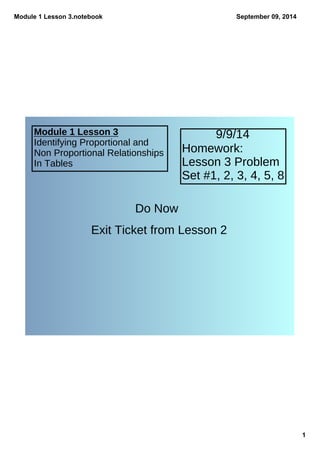
Module 1 lesson 3
- 1. Module 1 Lesson 3.notebook 1 September 09, 2014 Module 1 Lesson 3 Identifying Proportional and Non Proportional Relationships In Tables 9/9/14 Homework: Lesson 3 Problem Set #1, 2, 3, 4, 5, 8 Do Now Exit Ticket from Lesson 2
- 2. Module 1 Lesson 3.notebook 2 September 09, 2014
- 3. Module 1 Lesson 3.notebook 3 September 09, 2014
- 4. Module 1 Lesson 3.notebook 4 September 09, 2014
- 5. Module 1 Lesson 3.notebook 5 September 09, 2014
- 6. Module 1 Lesson 3.notebook 6 September 09, 2014 8 16 24 32 36 40 48 52
- 7. Module 1 Lesson 3.notebook 7 September 09, 2014 If the hours change, does that mean the pay MUST change?
- 8. Module 1 Lesson 3.notebook 8 September 09, 2014 How did you determine the pay for hours?
- 9. Module 1 Lesson 3.notebook 9 September 09, 2014 Describe the relationship between the amount of money earned and the number of hours worked in this example.
- 10. Module 1 Lesson 3.notebook 10 September 09, 2014 Describe the relationship between the amount of money earned and the number of hours worked in this example. The two quantities are in a proportional relationship since time can be multiplied by the same number to get the amount of pay.
- 11. Module 1 Lesson 3.notebook 11 September 09, 2014 How can multiplication and division be used to show the earnings are proportional to the number of hours worked?
- 12. Module 1 Lesson 3.notebook 12 September 09, 2014 How can multiplication and division be used to show the earnings are proportional to the number of hours worked? Every measure of time (hours) can be multiplied by the constant 8 to get each measure of pay. Each measure of y (pay) can be divided by 8 to get the corresponding x (hours).
- 13. Module 1 Lesson 3.notebook 13 September 09, 2014 8 16 24 32 36 40 48 52
- 14. Module 1 Lesson 3.notebook 14 September 09, 2014 8 16 24 32 36 40 48 52 Yes, pay is proportional to hours because when hours are multiplied by 8, it gives the corresponding pay amount.
- 15. Module 1 Lesson 3.notebook 15 September 09, 2014 Get into pairs and complete Examples 1 4
- 16. Module 1 Lesson 3.notebook 16 September 09, 2014
- 17. Module 1 Lesson 3.notebook 17 September 09, 2014
- 18. Module 1 Lesson 3.notebook 18 September 09, 2014
- 19. Module 1 Lesson 3.notebook 19 September 09, 2014
- 20. Module 1 Lesson 3.notebook 20 September 09, 2014 Closure How can you use a table to determine whether the relationship between two quantities is proportional?
- 21. Module 1 Lesson 3.notebook 21 September 09, 2014